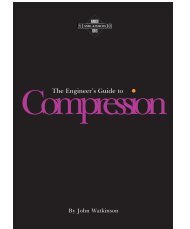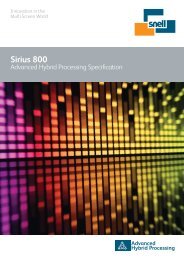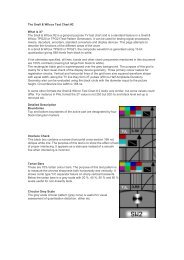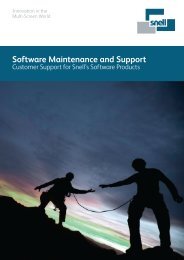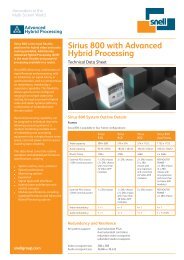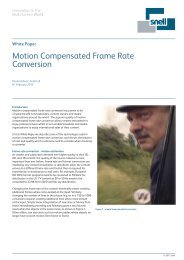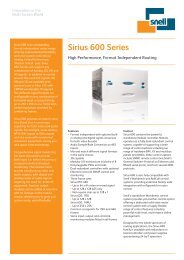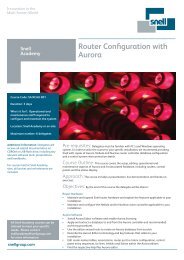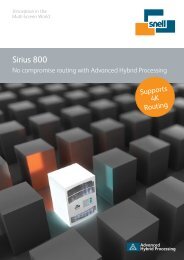The Engineer's Guide to Standards Conversion - Snell
The Engineer's Guide to Standards Conversion - Snell
The Engineer's Guide to Standards Conversion - Snell
Create successful ePaper yourself
Turn your PDF publications into a flip-book with our unique Google optimized e-Paper software.
a)<br />
Drama<br />
aperture<br />
+525<br />
c/ph<br />
Vertical<br />
frequency<br />
+525<br />
c/ph<br />
Vertical<br />
frequency<br />
-525<br />
c/ph<br />
-60Hz<br />
Temporal<br />
frequency<br />
+60Hz<br />
-525<br />
c/ph<br />
-60Hz<br />
Temporal frequency<br />
+60Hz<br />
b)<br />
Sports<br />
aperture<br />
+525<br />
c/ph<br />
Vertical<br />
frequency<br />
+525<br />
c/ph<br />
Vertical<br />
frequency<br />
-525<br />
c/ph<br />
-60Hz<br />
Temporal<br />
frequency<br />
+60Hz<br />
-525<br />
c/ph<br />
-60Hz<br />
Temporal frequency<br />
+60Hz<br />
Fig 3.6.2 <strong>The</strong> responses of the filter in the ACE converter.<br />
a) <strong>The</strong> response optimised for drama,<br />
b) <strong>The</strong> response optimised for pans <strong>to</strong> reduce judder.<br />
In order <strong>to</strong> return <strong>to</strong> a continuous spectrum, each spectral line is replaced by a<br />
sinx/x spectrum c) which is in fact the transform of the rectangular windowed). <strong>The</strong><br />
sinx/x spectra are added <strong>to</strong> give the continuous spectrum e). It will be seen from e)<br />
that even though the frequency response is specified at zero at the discrete points,<br />
the sinx/x spectral components cause it <strong>to</strong> be non-zero between those points. This is<br />
the cause of s<strong>to</strong>p band ripple. <strong>The</strong> art of filter design is <strong>to</strong> juggle the passband<br />
spectrum so that the tails of the sinx/x impulses cancel one another out rather than<br />
reinforcing. As the effects of beat frequencies are subjectively very irritating, it is<br />
better <strong>to</strong> eliminate them at the expense of some premature roll-off of the passband.<br />
Today software packages are available which allow the optimising process <strong>to</strong> be<br />
au<strong>to</strong>mated. Fig 3.6.2 shows the responses of the filter used in the ACE standards<br />
converter. Clearly the response must be different depending on the direction of<br />
conversion as the position of input frequencies needing most suppression depends<br />
on the input spectrum. <strong>The</strong> ideal triangular response worked well on material such<br />
as studio drama, but was found <strong>to</strong> cause excessive judder on pans. As a result an<br />
alternative diamond shaped response was made available which reduced judder at<br />
the cost of increased motion blur.<br />
44



